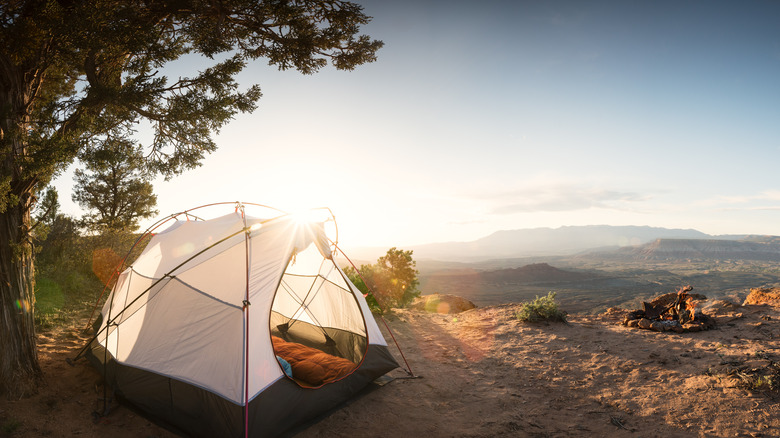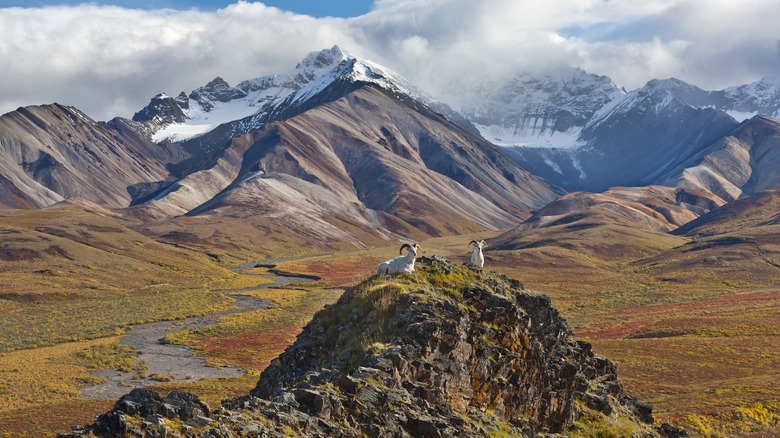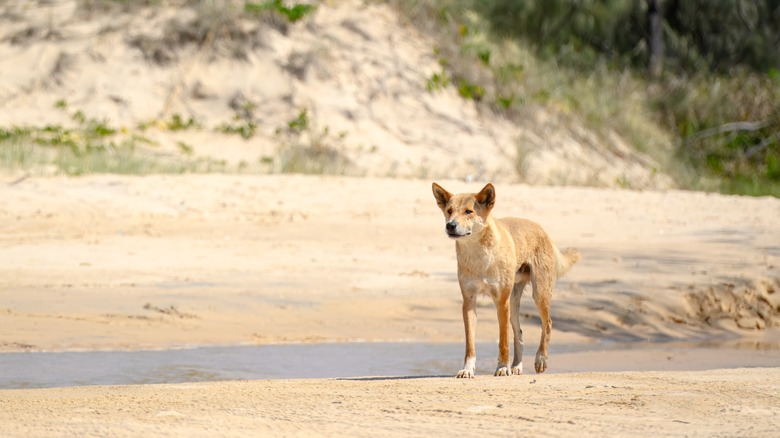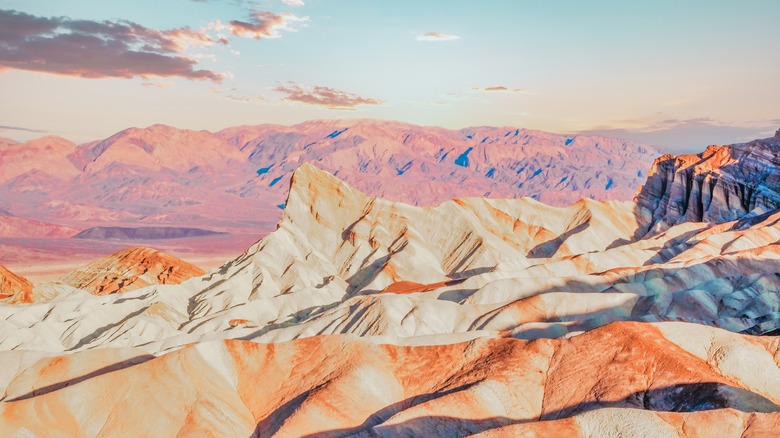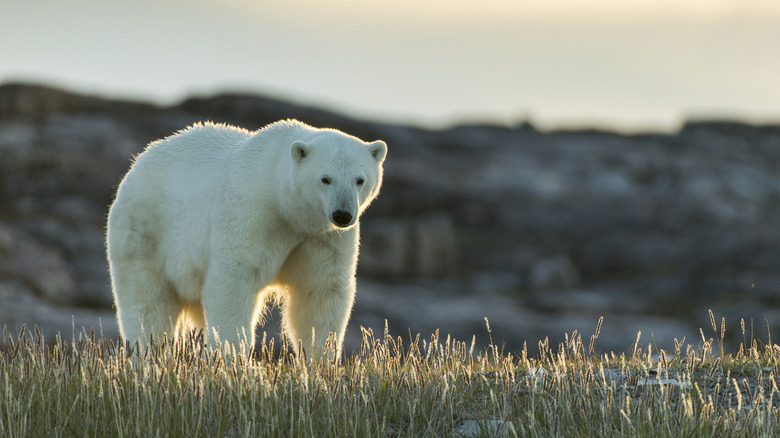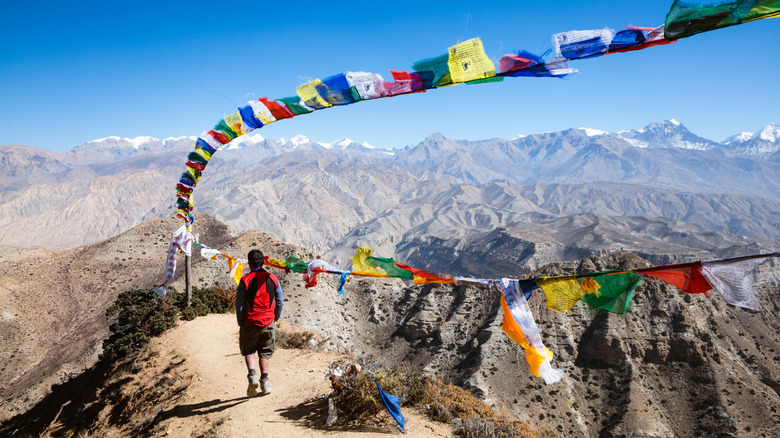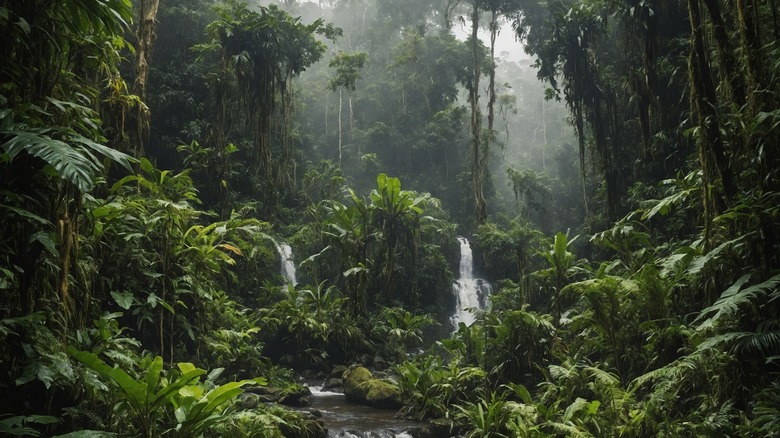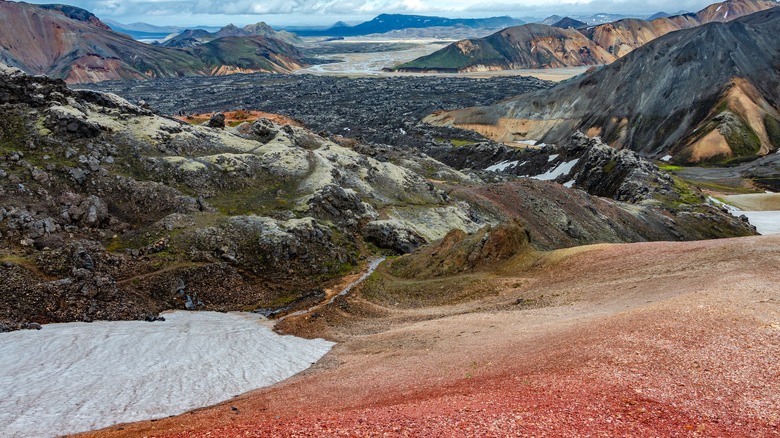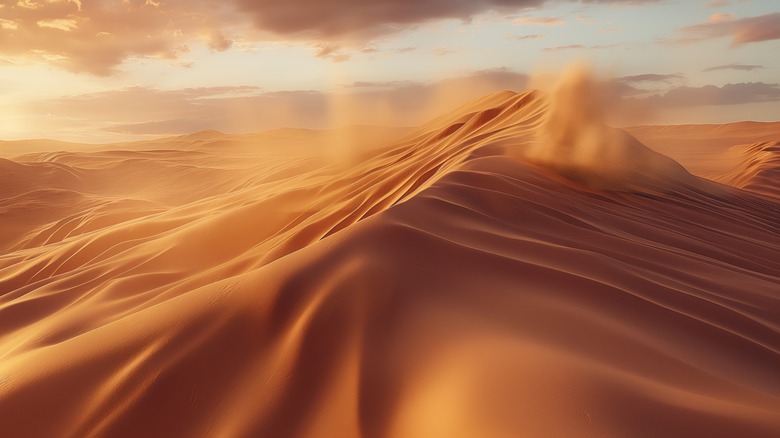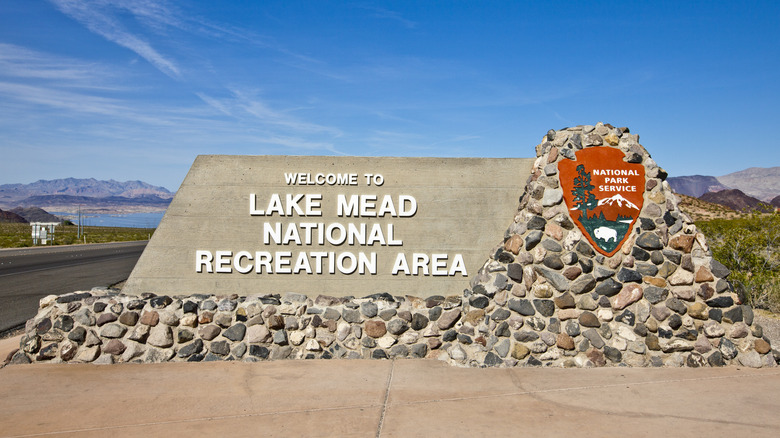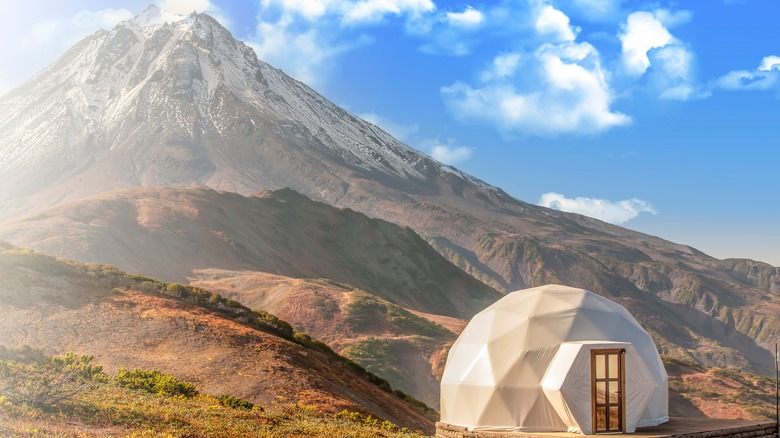The Most Dangerous Camping Destinations In The World
Mother Nature is awe-inspiring and magical, but she can also be wild and, at times, dangerously unpredictable. Camping is one of the most exhilarating ways to connect with nature, offering a chance to escape the stress of modern life and fully immerse yourself in the simplicity of the great outdoors — just make sure you're well-packed for a quick and easy camping retreat. Whether it's the joy of stargazing under clear skies, waking up to the sounds of a soothing stream, or getting cozy next to a campfire, camping offers an enjoyable experience in the wonders of the natural world. Plus, hanging out in nature can help reduce stress and anxiety, and studies suggest that spending at least 2 hours per week in nature can significantly enhance your overall health, according to the American Heart Association.
While the rewards are great, camping also comes with some risks. Some might say the unknown aspect of camping is what gives it its charm. But sometimes, even the most seasoned adventurers can find themselves in sticky situations — unpredictable weather, precarious wildlife, or harsh terrain can ruin even a well-planned vacation. In this article, we'll explore some of the most dangerous camping destinations around the globe, revealing Mother Nature's wild side. These places, while stunningly beautiful, require plenty of preparation, as they push the boundaries of safety and survival. So before you pack your bags and head off into the wilderness, let's take a look at the potential risks lurking in some of the world's wildest camping spots.
Denali National Park, Alaska, USA
Denali National Park is located in south-central Alaska. It spans over 6 million acres and is home to North America's tallest peak — Denali — which rises to 20,310 feet. The park is about 240 miles north of Anchorage and 125 miles south of Fairbanks, making it an extremely remote and rugged destination for outdoor enthusiasts, hours away from the nearest hospital. Most travelers are drawn to Denali National Park to experience its breathtaking landscapes, catch sight of the towering Denali peak, and get their chance to witness wildlife. But be careful what you wish for — this area is home to potentially dangerous wildlife, including black bears and grizzly bears.
According to the Denali National Park website: "Do not begin a trip hoping to avoid bears; expect you will encounter them, and be prepared for the event." The website offers plenty of bear encounter safety tips, including how to properly use bear spray (make sure to carry some with you at all times). Another potential danger is Denali's harsh environment and erratic weather, which makes it a treacherous place for tent campers, especially those unprepared for extremely cold weather. This subarctic region can experience cold and rainy days, even in the summer, and hypothermia is a risk at any time of year. Make sure to pack rain gear and lots of layers, particularly wool or synthetic materials that can keep you warm even when wet.
Fraser Island, Queensland, Australia
Fraser Island is a stunning Australian island with World Heritage Site status. It's also known as K'gari, its Aboriginal name, and is located off the gorgeous southeastern coast of Queensland, Australia. It is the largest sand island in the world, stretching over 122 kilometers (75 miles) in length, and is famous for its unique ecosystems, which include tropical rainforests growing on sand, freshwater lakes, and long stretches of stunning sand dune beaches. These unique characteristics landed Fraser Island on the UNESCO World Heritage Site list.
However, a trip to Fraser may not be the perfect peaceful vacation. According to Culture Trip, Fraser Island is the "Number one most dangerous beach in the world." With no medical facilities on the island, rescue helicopters are often flown in to assist travelers in need of emergency help. So what makes Fraser Island so risky? For one, the dingos. Don't let their cute, cuddly looks fool you — even though they seem like adorable dogs, they are wild animals native to Australia and have been known to attack humans. Additionally, many injuries occur each year from car accidents, often caused by reckless driving on sand dunes or getting stuck in boggy sand causing a rollover.
Many dangers are lingering offshore, too. The waters are teeming with great white sharks and stinging jellyfish, including Irukandji jellyfish and blue bottles, both of which require medical attention if you are stung. The ocean waves are also known to be rough on the eastern shore, often with hazardous rip tides and no lifeguards in sight.
Death Valley National Park, California, USA
Anything that has "death" in its name must be dangerous, right? According to the National Park website, "Death Valley is famous as the hottest place on earth and driest place in North America." The highest air temperature ever recorded on Earth was 134 degrees (56.7 Celsius) at Furnace Creek Ranch in Death Valley on July 10, 1913. Average summer temperatures in this national park, which you may want to avoid visiting in the summer for your safety, often hover around a sweltering 120 degrees (49 Celsius), with nighttime temperatures never dipping below 90 degrees (32 Celsius). Death Valley's extreme temperatures can quickly become unsafe for campers without proper hydration or shelter. It's also important to keep up to date with the weather forecast, as late summer thunderstorms can cause flash floods in the area.
The harsh desert environment is also home to lots of wildlife, including multiple types of rattlesnakes: the Mojave Desert sidewinder, the Mojave rattlesnake, and the Panamint rattlesnake. Rattlesnake bites are extremely painful — and poisonous — requiring immediate medical attention. Our best advice: drink lots of water, and avoid camping in Death Valley in summertime, when it's nearly impossible to escape the heat. Plus, rattlesnakes are less active in the winter — it's a win-win.
Torngat Mountains National Park, Labrador, Canada
This country is rich with polar bears. Torngat Mountains National Park is located on an Inuit-run reserve in Labrador, Northeastern Canada. The Torngat Mountains are one of the few places in Canada where polar bears, known as nanuk to the Inuit locals, are common — and they pose a serious threat to campers. Adam Leith Gollner wrote about a recent trip in the Smithsonian Magazine: "I lost count of how many nanuks I saw, often just yards away, in the space of four days." Polar bear sightings are so common that it's highly recommended to travel with an experienced Inuit polar bear guard who can help protect you.
One group of campers, after failing to follow safety guidelines, awoke in the middle of the night to find a polar bear dragging one of their group members from their tent. The polar bear had torn through the safety electric fence they had set up around their campsite to deter it, according to CBC. They managed to scare the bear away but had to endure a six-hour wait for a helicopter to arrive and provide assistance. This region is extremely remote and only accessible five weeks out of the year. The Torngat Mountains Base Camp requires every visitor to watch a polar bear safety video before embarking into the wilderness and strongly advises carrying electric fences and bear deterrents like loud light flares and air horns, in addition to being escorted by an armed Inuit guide.
Himalayan Mountains, Asia
The Himalayas are breathtaking in two big ways: their beauty is astonishing, and their high altitude will likely leave you short of breath. Towering at heights above 24,000 feet (7,300 meters), altitude sickness is a real risk in the Himalayan Mountains. This medical condition can occur when you quickly transition to a higher altitude and your body doesn't have enough time to adjust, leading to symptoms like headache, nausea, fatigue, trouble sleeping, dizziness, and vision problems (via Cleveland Clinic). Severe cases can cause brain swelling or your lungs to fill with fluids — both of which are life-threatening — so it's important to notice the signs and seek medical treatment if needed.
Higher altitudes also bring colder weather and freezing temperatures. Be sure to check the weather forecast for the region you are visiting and pack plenty of layers to keep you warm on those brisk chilly nights. Cristina Podocea writes about camping in the Himalayas: "Here I am ... lying in my tent and listening to the snowfall on the outer lining of my tent. I wonder if it will hold. I have a headache as I am at 4650 meters ... It is difficult to sleep at this altitude. Plus, it is cold. I am wearing all my clothes and my sleeping bag is quite warm, but I still feel a shiver from time to time. The nights seem so long ..." (via Inside Himalayas).
The Amazon Rainforest, South America
The Amazon rainforest is famous worldwide, and for good reason — it's the single largest tropical rainforest on the planet. Covering nearly 3.2 million square miles across nine countries, the Amazon is renowned for housing almost one-third of the world's species and holding 25 percent of Earth's freshwater, according to The Nature Conservancy. It's also home to 21 million people, including 200 Indigenous communities. With that kind of reputation, it's no surprise that tourists from around the globe are eager to visit and immerse themselves in its beauty.
The risks of the Amazon lie mostly in its vast array of poisonous and dangerous animals you wouldn't want to see in a rainforest, including venomous pit vipers, South American rattlesnakes, electric eels, giant centipedes, bull sharks, poison dart frogs, Brazilian wandering spiders, and jaguars — just to name a few. Mosquitoes also pose a big threat to humans, since many carry two different diseases, both of which can be deadly: malaria and yellow fever. "The biggest danger, reported by almost everyone who has had the ability to visit the Amazon, is getting some kind of illness," according to Andean Great Treks. Before taking a trip to the Amazon, it's highly recommended to consult with a healthcare provider or travel clinic to update your vaccines for malaria, meningitis, rabies, and more. Additionally, bring any recommended anti-malaria medications and other medical supplies as suggested by your doctor.
Laugavegur Trail, Iceland
Iceland is an adventurer's dream come true, offering breathtaking natural beauty — from relaxing geothermal hot springs and black sand beaches to ice caves, volcanoes, glaciers, and waterfalls — along with the unforgettable opportunity to witness the Northern Lights. What more could you ask for? One of the most exhilarating ways to experience the natural wonders of Iceland is by backpacking and camping along the way. A standout adventure is the Laugavegur Trail, a famous 4-day trek along the 34-mile trail across the southern Icelandic highlands. The trail offers amazing sights of colorful mountains, lava fields, snowy glaciers, and even some geothermal hot springs.
This region is gorgeous but can be risky any time of year due to turbulent and extreme weather conditions, ranging from high winds, rain, and snow (which can occur even in the summer), and dense fog, which can make navigation difficult. One weary traveler on TripAdvisor wrote: "Yes, this place is fantastic, but ... we got lost in the fog ... and I think that we could have died there if the weather conditions had worsened. Weather in Iceland is seldom good according to Alpine standards: most of the time it remains cloudy with several showers a day." The trail also passes through volcanic areas where eruptions and geothermal activity can occur and require several river crossings that can be dangerous depending on the water levels. The journey is absolutely worth it, but it requires thorough research and preparations to ensure you make it home safely!
Sahara Desert, Northern Africa
The Sahara is an iconic desert, home to a variety of dramatic and diverse landscapes, including towering sand dunes, rocky plateaus, oases, and salt flats. The vastness and unpredictability of the Sahara Desert can present some challenges (or adventures, depending on your perspective) for those camping without proper preparation and supplies — but don't let that keep you away from this natural wonder. Potential dangers include extreme heat, inconsistent weather, dehydration, sandstorms, and encounters with scorpions.
One of the best ways to enhance your safety is by traveling with a local guide. Locals have a deep understanding of the desert and are equipped with the necessary experience and supplies to handle extreme weather, sandstorms, and more. Pack plenty of water — more than you might expect — and don't forget sunscreen, bug spray, and any other items recommended by your guide. To cope with the desert heat, wear loose, lightweight, and breathable clothing. Additionally, consider bringing accessories for sun and sand protection, such as a wide-brimmed hat, sunglasses, and a scarf. With the proper gear and the right attitude, camping in the Sahara Desert will be a pleasantly unforgettable experience.
Lake Mead National Recreation Area, Arizona/Nevada, USA
This location landed on our list because while beautiful, this unsuspecting national park is considered America's most dangerous. Lake Mead National Recreation Area is located on the border of Nevada and Arizona, encompassing the area around Lake Mead, which was created by the Hoover Dam on the Colorado River. The region is a popular recreation destination, offering a variety of outdoor activities such as boating, fishing, hiking, and camping, but it's far from the safest. According to 8 News Now, 19 people have died so far in the year 2024. In 2023, there were a total of 29 fatalities. Since 2007, the average number of deaths per year has been approximately 18.6. The majority of deaths have been attributed to drowning, with car crashes being the second leading cause.
By far, the most treacherous thing you can do at Lake Mead is go swimming. The lake water is vast, deep, and volatile, with strong winds changing currents at a moment's notice, making it difficult to swim. Pool toys like inner tubes are prohibited in the lake to minimize the risk of individuals being swept too far from shore and unable to return, which could — and has — resulted in drowning. Although it may seem "uncool," wearing a life jacket significantly reduces your risk of drowning and could save your life.
Kamchatka Peninsula, Russia
The Kamchatka Peninsula is located in the far eastern part of Russia. It extends into the North Pacific Ocean and is bordered by the Bering Sea and the Sea of Okhotsk. The peninsula is known for its striking landscapes, including 300 volcanoes, geysers, hot springs, and diverse wildlife, making it a hot spot for adventure tourism and nature enthusiasts. The two main things that draw travelers to the Kamchatka Peninsula are also what makes it perilous: bears and volcanoes. Both are unpredictable.
Russia's Kamchatka Peninsula hosts one of the largest concentrations of active volcanoes in the world — with a total of 29 active volcanoes in the region. On average, Kamchatka's volcanoes erupt three to four times per year, sending rocks and ash everywhere, including high into the atmosphere.While scientists have developed methods to monitor and assess volcanic activity, accurately forecasting an eruption remains a challenge. Your best bet is to avoid camping in this region and opt for a helicopter tour of the area to catch glimpses of the active volcanoes. If you do decide to go camping, watch for signs of a potential eruption, like small earthquakes and heavy steaming from the volcano. And be sure to brush up on your bear safety skills, and don't forget your bear spray.
